Top Rankings
Snohomish School District ranks among the top 20% of public school district in Washington for:
Category
Attribute
Overall Rank
Highest overall rank (Top 20%)
Math Proficiency
Highest math proficiency (Top 20%)
Reading/Language Arts Proficiency
Highest reading/language arts proficiency (Top 20%)
Science Proficiency
Highest science proficiency (Top 20%)
Community Size
Largest student body (number of students) (Top 1%)
For the 2025 school year, there are 6 public high schools serving 3,459 students in Snohomish School District. This district's average high testing ranking is 10/10, which is in the top 10% of public high schools in Washington.
Public High Schools in Snohomish School District have an average math proficiency score of 47% (versus the Washington public high school average of 35%), and reading proficiency score of 77% (versus the 65% statewide average).
Public High School in Snohomish School District have a Graduation Rate of 90%, which is more than the Washington average of 84%.
The school with highest graduation rate is Glacier Peak High School, with 96% graduation rate. Read more about public school graduation rate statistics in Washington or national school graduation rate statistics.
Minority enrollment is 31% of the student body (majority Hispanic), which is less than the Washington public high school average of 50% (majority Hispanic).
Overview
This School District
This State (WA)
# Schools
19 Schools
862 Schools
# Students
9,840 Students
392,615 Students
# Teachers
503 Teachers
19,037 Teachers
Student : Teacher Ratio
19:1
19:1
District Rank
Snohomish School District, which is ranked within the top 20% of all 306 school districts in Washington (based off of combined math and reading proficiency testing data) for the 2021-2022 school year.
The school district's graduation rate of 90% has increased from 87% over five school years.
Overall District Rank
#48 out of 307 school districts
(Top 20%)
(Top 20%)
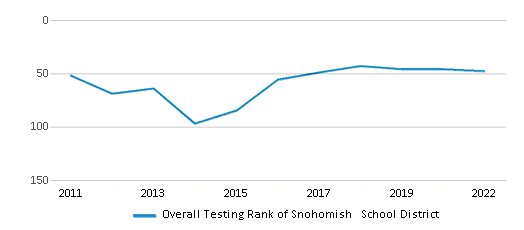
Math Test Scores (% Proficient)
50%
40%

Reading/Language Arts Test Scores (% Proficient)
61%
53%
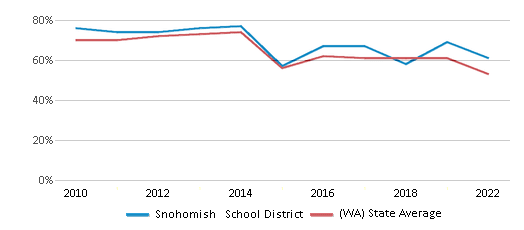
Science Test Scores (% Proficient)
55%
49%
Graduation Rate
90%
84%
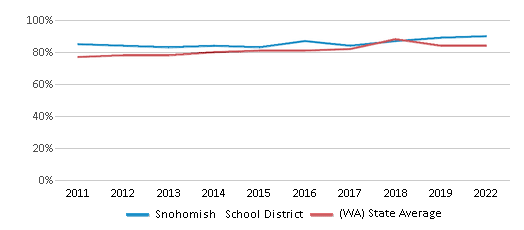
Students by Ethnicity:
Diversity Score
0.52
0.68
# American Indian Students
61 Students
6,222 Students
% American Indian Students
1%
2%
# Asian Students
835 Students
31,721 Students
% Asian Students
9%
8%
# Hispanic Students
1,370 Students
98,262 Students
% Hispanic Students
14%
26%
# Black Students
115 Students
18,031 Students
% Black Students
1%
5%
# White Students
6,615 Students
191,731 Students
% White Students
67%
50%
# Hawaiian Students
19 Students
5,281 Students
% Hawaiian Students
n/a
1%
# Two or more races Students
773 Students
32,269 Students
% of Two or more races Students
8%
8%
Students by Grade:
# Students in PK Grade:
161
1,298
# Students in K Grade:
713
1,800
# Students in 1st Grade:
745
1,949
# Students in 2nd Grade:
752
2,043
# Students in 3rd Grade:
704
2,225
# Students in 4th Grade:
673
2,376
# Students in 5th Grade:
698
2,423
# Students in 6th Grade:
647
4,808
# Students in 7th Grade:
721
8,534
# Students in 8th Grade:
655
10,258
# Students in 9th Grade:
819
86,766
# Students in 10th Grade:
827
88,756
# Students in 11th Grade:
830
87,586
# Students in 12th Grade:
895
91,793
# Ungraded Students:
-
-
District Revenue and Spending
The revenue/student of $18,319 in this school district is less than the state median of $18,796. The school district revenue/student has stayed relatively flat over four school years.
The school district's spending/student of $16,106 is less than the state median of $19,246. The school district spending/student has stayed relatively flat over four school years.
Total Revenue
$180 MM
$20,715 MM
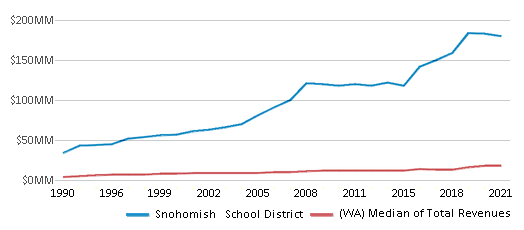
Spending
$159 MM
$21,212 MM
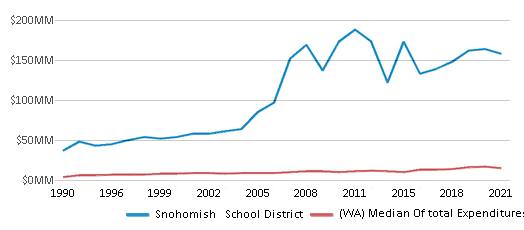
Revenue / Student
$18,319
$18,796
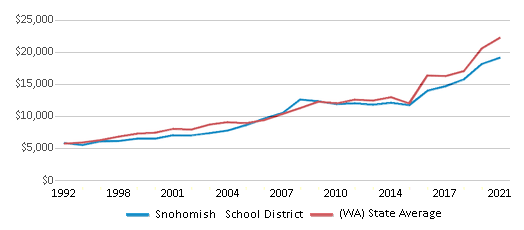
Spending / Student
$16,106
$19,246
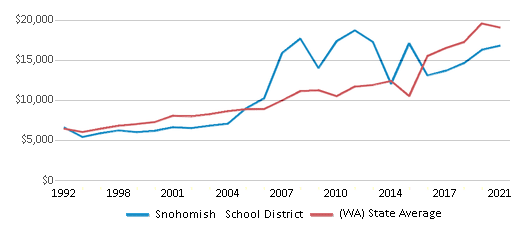
Best Snohomish School District Public High Schools (2025)
School
(Math and Reading Proficiency)
(Math and Reading Proficiency)
Location
Grades
Students
Rank: #11.
Glacier Peak High School
(Math: 58% | Reading: 87%)
Rank:
Rank:
10/
Top 10%10
7401 144th Pl Se
Snohomish, WA 98296
(360) 563-7300
Snohomish, WA 98296
(360) 563-7300
Grades: 9-12
| 1,630 students
Rank: #22.
Snohomish High School
(Math: 38% | Reading: 71%)
Rank:
Rank:
8/
Top 30%10
1316 Fifth Street
Snohomish, WA 98290
(360) 563-4019
Snohomish, WA 98290
(360) 563-4019
Grades: 9-12
| 1,525 students
Rank: #33.
Parent Partnership
Alternative School
(Math: 30-39% | Reading: 50-59%)
Rank:
Rank:
6/
Top 50%10
525 13th Street
Snohomish, WA 98290
(360) 563-3401
Snohomish, WA 98290
(360) 563-3401
Grades: K-12
| 103 students
Rank: #44.
Snohomish Center
Special Education School
(Math: <50% | Reading: <50% )
Rank:
Rank:
5/
Bottom 50%10
1601 Avenue D
Snohomish, WA 98290
(360) 563-7264
Snohomish, WA 98290
(360) 563-7264
Grades: PK-12
| 16 students
Rank: #55.
High School Re Entry
Alternative School
(Math: <50% | Reading: <50% )
Rank:
Rank:
4/
Bottom 50%10
525 13th St
Snohomish, WA 98290
(360) 563-3401
Snohomish, WA 98290
(360) 563-3401
Grades: 9-12
| 24 students
Rank: #66.
Aim High School
Alternative School
(Math: ≤20% | Reading: 40-59%)
Rank:
Rank:
3/
Bottom 50%10
525 13th St
Snohomish, WA 98290
(360) 563-3401
Snohomish, WA 98290
(360) 563-3401
Grades: 9-12
| 161 students
Recent Articles

What Is A Charter School?
Explore the world of charter schools in this comprehensive guide. Learn about their history, how they operate, and the pros and cons of this educational innovation. Discover key facts about charter schools, including admission policies, demographics, and funding, as well as what to look for when considering a charter school for your child.

10 Reasons Why High School Sports Benefit Students
Discover the 10 compelling reasons why high school sports are beneficial for students. This comprehensive article explores how athletics enhance academic performance, foster personal growth, and develop crucial life skills. From improved fitness and time management to leadership development and community representation, learn why participating in high school sports can be a game-changer for students' overall success and well-being.

February 05, 2025
Understanding the U.S. Department of Education: Structure, Impact, and EvolutionWe explore how the Department of Education shapes American education, from its cabinet-level leadership to its impact on millions of students, written for general audiences seeking clarity on this vital institution.





